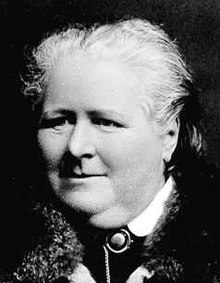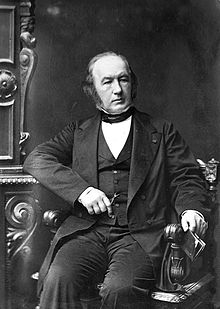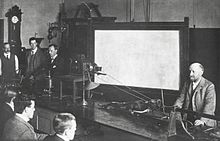Browndog affair

The Brown Dog affair ( en : brown dog affair ) was a political controversy about interventions in living animals for scientific purposes ( vivisection ) in Edwardian England ( 1902-1910 ). London medical seminars were infiltrated by a group of Swedish antivisectionists and there were several street battles between medical students and the police. The Royal Courts of Justice were negotiating several defamation suits and a Royal Commission was set up to review the legality of the use of animals in experiments. The affair polarized both academics and the rest of the English population.
It was triggered in February 1903 by the accusation that William Bayliss had carried out an illegal dissection of a brown terrier at the Department of Physiology at University College London - according to his own statements under proper anesthesia, according to the antivivisectionists with full consciousness. The Anti-Vivisection Society condemned the act as a cruel injustice. Bayliss, whose research on dogs made a key contribution to understanding hormones , successfully brought a libel suit in court .
The animal rights activists set up in response to the judgment in 1906 a bronze statue of the dog in Battersea. The medical faculty, especially the students, felt provoked by the inscription:
"Men and women of England, how long should these things last?"
The statue fell victim to several vandals and was then temporarily guarded around the clock to prevent actions by the so-called anti-doggers . On December 10, 1907, 1,000 of them marched through central London and, in a violent escalation, clashed with suffragettes , trade unionists and around 400 police officers in Trafalgar Square . It also came in the aftermath repeatedly to similar street battles as the Brown Dog riots ( Brown Dog riots were known).
Under the pressure of the controversy, the statue was secretly removed in 1910 by the district council, which it claims was supported by a petition with 20,000 signatories. A new statue was erected in Battersea Park in 1985 .
Political background
Walter Gratzer , Professor of Biochemistry at King's College, reports of strong opposition to vivisection practice in England during the reign of Queen Victoria , represented equally in the House of Commons and in the House of Lords . Unlike today, the term vivisection included the dissection of living animals, with or without anesthesia, usually for the training of medical students.

After Gratzer, several better-known surgeons, such as Claude Bernard , Charles Richet , Michael Foster or Burdon Sanderson, were criticized for their work. Bernard in particular was the target of violent protests on several occasions, including from his own family.
In December 1875, Frances Power Cobbe founded the British National Anti-Vivisection Society (NAVS, roughly: British Society against Vivisection ). At the time, about 300 animal experiments were being conducted annually in the UK. As early as July, a less organized opposition managed to convene a Royal Commission, which submitted legislative proposals to the government. A second commission was convened in 1906 because of the Brown Dog affair. The first commission submitted the Cruelty to Animals Act 1876 , (about: Law against cruelty to animals ), which legalized the practice, which was not considered legally, but also made it subject to regulations. The NAVS criticized him as vicious, but well titled The law was more than 110 years in power and was the Animals (Scientific Procedures) Act 1986 (about: Law to animals in academic ventures ) replaced that of the modern animal rights movement is similarly criticized.
The Cruelty to Animals Act stipulated that researchers could not be prosecuted for cruelty, but that animals in the experiments must be anesthetized, used only once and killed after the experiment. These restrictions were subject to the proviso that the successful outcome of the experiment should not be endangered by them. Prosecution under the law was only possible with the consent of the Home Secretary , then Aretas Akers-Douglas, 1st Viscount Chilston .
Experiments by Starling and Bayliss
In the early twentieth century, Ernest Starling and his brother-in-law William Bayliss studied a thesis by Ivan Pavlov about interactions between the nervous system and the pancreas with the help of vivisection.
It was known that increased acid concentrations in the duodenum and jejunum promoted the production of digestive secretions . By severing duodenal and jejunal nerves, but leaving the blood supply intact and adding small amounts of acid, they discovered that the reaction occurs through a chemical reflex , independent of neural interactions. They called the chemical messenger substance secretin .
Based on her experiments, Starling coined the term hormone in 1905 for substances that mediate similar control processes. Bayliss and Starling also described peristalsis in 1899 based on experiments with vivisection.
Vivisection of the dog
Infiltration by Swedish activists
The seminars were infiltrated by two Swedish activists without the knowledge of the professors: Louise Lizzy Lind-af-Hageby , a 24-year-old countess, and Leisa K. Schartau visited the Pasteur Institute in Paris around 1900 and were already there against the use of Animals for teaching. After their return to Sweden they made contacts with the Swedish Animal Welfare League and founded an anti-divisectionist national association. In 1902 they enrolled at the London School of Medicine for Women - a vivisection-free institute with contacts to other London institutes - on the one hand to gain medical education and on the other hand to prepare for the planned infiltration.
They also attended seminars at King's and University College and kept a detailed diary, which they published in 1903 under the title Eyewitnesses . It contributed significantly to the polarization of the topic and received some 200 reviews in the four months after it was published.
Role of the antivisectionist association
The authors decided to call in lawyer Stephen Coleridge from the NAVS, formerly Lord Chief Justice of England and Wales . In his estimation, the statements of the women, according to which the dog was used for a total of three experiments, killed by a student and also made jokes and jokes during the vivisections, would not have been sufficient to enforce a conviction under the Cruelty to Animals Act. Instead, he gave a provocative speech in May 1903, St. James Hall , in which he accused the scientists of sloppiness, carelessness and torture, possibly in order to provoke a defamation suit in order to bring the subject to court and to the public.
A print appeared in the Daily News , among others , but also in other local and national media.
Bayliss vs. Coleridge
Bayliss hired his attorney, Rufus Isaacs , and the defamation lawsuit went public on November 11, 1903, in the Royal Court of Justice . At the trial, Stirling stated that he had broken the law by repeatedly using the dog, but that he had avoided killing two other dogs. In addition, the dog was anesthetized with morphine , alcohol and ether . The movements were symptoms of the dog's chorea , a disease in which involuntary spasms occur. Because a tracheostomy was performed, the women's claims that the dog howled or whined could not be true.
The two women testified that they were in the operating room before the other students. While they were alone with the dog for about two minutes, they examined it and observed scars from previous procedures and incisions on the neck with small protruding tubes. They couldn't smell any anesthetics. The dog made movements that they classified as "conscious".
The court ruled that there was defamation and awarded Bayliss £ 2,000 and £ 3,000 in costs. This is equivalent to about £ 250,000 today (2004). There are various reports about the public reception. The Edinburgh Medical Journal and the Times reported that the verdict was overwhelmingly positive, almost euphoric. The Daily News called it a misjudgment and set up a fund to cover Coleridge's expenses. Within a few months they raised £ 5,700. According to Gratzer, parts of the fund that Coleridge later donated will be used around 2009 to buy animals out of research facilities.
Ernest Bell of The Shambles of Science and other media representatives who had reprinted Coleridge's speech apologized to Bayliss and withdrew the relevant issue. Towards the end of 1913, the AVS printed the fifth edition of the students' reports. The chapter Fun (“Fun”), which, in addition to vivisection, also described the unconcerned behavior of fellow students, was kept more descriptive and renamed The Vivisection of the Brown Dog .
Memory of the Brown Dog
After the hearing, Anna Louisa Woodward suggested the idea of a public commemoration. Together with the sculptor Joseph Whitehead, she donated a bronze statue on a 2.30 m high granite plinth, in which a trough for people and another for animals was built.
The working-class Battersea district was intended for the statue, where many institutions supported the anti-divisectionist movement. There was overlap between the animal rights movement , the labor movement and the movement of suffragettes who fought for women's suffrage. The author Matthias Rude writes that the antivivisection movement was "so linked to the feminist movement of the time that the medical students at the University College who protested against the erection of the monument from 1906 onwards equated the antivivisection and women's suffrage movement: They disrupted numerous events of the latter to take action against the former. Medical students try again and again to destroy the monument, but encounter vehement resistance from the opponents of vivisection as well as the population of the working class, who apparently see the dog as a symbol of their own oppression. "
The Battersea General Hospital refused to perform live tests on animals or to hire doctors who were working in relevant research institutions. People also called it the antiviv or the old anti . The Battersea Dog Home was also known to disapprove of such practices as not just terrible but absurd .
The district council agreed to provide space on the newly opened Latchmere Estate , a neighborhood that was considered cheap housing for workers. On September 15, 1906, the sculpture was inaugurated in front of a large audience and accompanied by speeches by Bernhard Shaw and Charlotte Despard . The inscription triggered some violent reactions. So wrote New York Times by a hysterical language as it is usual for the Antivivisektionisten and a [r] insult to the entire science.
“In memory of the brown terrier who was put to death in the laboratories of the University College of London in February 1903 after suffering two months of vivisection and being passed from one vivisector to the next until death delivered him. Also in memory of the 232 dogs that were dissected alive at the same location in 1902. Men and women of England, how long are these things going to last? "
Riots
While the institute examined legal action in the first year after it was established, the situation gradually escalated as this path got lost. From November 1907 there were regular protests by medical students. On November 20, a group of students, led by William Howard Lister , marched against the statue with crowbars and sledgehammers. There were ten arrests. The following day, others protested the sentences that had been imposed. Another hundred demonstrators marched on November 25th.
On December 10, 1907, a rugby match between the Oxford and Cambridge teams took place in West Kensington . Among the numerous student audience, the antidoggers hoped to be able to recruit fellow campaigners. A student mob tried various ways to reach the statue, but was pushed back by a worker mob. In Trafalgar Square that day, around 1,000 students met 300 workers and 400 police officers.
On December 16, a suffragette congress was blown up by a few hundred students.
The question was raised in the House of Commons as to the proportionality of the costs to the public, which amounted to £ 700 in the relevant biennium. John Archer , first African American in public office and later mayor of Battersea, got the question out of the way. The Canine Defense League responded to the suggestion that antivisectionist associations should bear the costs incurred by threatening that the London institutes would have to pay for costs incurred as a result of vandalism, which was hardly practiced at their institutes at the time.
Susan McHugh of the University of New England saw the Brown Dog riots as an analogy between the various liberation movements that projected violence against the dog ( white , male , civic, and speciesist ) as a symbol of their own bondage.
In November 1910 a new Conservative District Council was elected. The question of the timeliness of the statue and other pretexts were discussed again. A support committee for the statue was formed by 500 individuals. The city council launched a petition against the statue by 20,000 signatories. A 1,500-strong demonstration led by Charlotte Despard and Louise Lind-af-Hageby followed in February 1910. Four city council members, accompanied by 120 police officers, removed the statue on the night of March 10th to 11th. Ten days later, 3,000 antivisectionists gathered, whom the city council ignored.
Reconstruction of the statue
Behind the Battersea Park pump house, the National Antivivisection Society and the British Union donated a new statue to the Abolition of Vivisection on December 12, 1985, presented by Geraldine James . The artist Nicola Hicks designed the statue.
“This statue replaces the old monument that was publicly donated to the Latchmere Recreation Ground in 1906. The dog's suffering led to rampant protests and mass demonstrations. It represents the rejection of vivisection and animal testing by the London people. This new monument is dedicated to the ongoing struggle to end these practices. As a result of heated controversy, the old one was removed on March 10th. The decision was made by the new city council after the previous city council supported the construction. Animal testing is a major ethical issue in our time and should have no place in a civilized society. In 1903, 19,084 animals suffered and died in British laboratories. In 1984 3,497,355 animals were burned, blinded, irradiated, poisoned and subjected to countless other terrifyingly cruel experiments in Great Britain. "
Mason complained that the statue was a pleasing contrast to its down-to-earth predecessor .
Hilda Kean criticized the new statue. The old Browndog was upright and defiant, did not beg for mercy and embodied a political demand. The new Browndog is more like its creator's pet. He doesn't point out any facts, but rather hides. In contrast to its ancestor, this dog will not unsettle anyone.
References
| Historical | Modern | |
|---|---|---|
|
Medical |
|
|
|
Vivisection |
|
|
Trivia
- Coult, Tony arranged a radio play, The Strange Affair of the Brown Dog , based on Peter Mason's book The Brown Dog Affair . It was first broadcast in 1998 with Maggie Steed , Louisa Woodward, Turan Ali and Nerys Hughes .
Individual evidence
- ↑ Anti-Speciesist Action Tübingen: Brown Dog riots: Alliances between workers, anti-divisional and women's movements , photos of the new statue.
- ^ Matthias Rude: Antispeciesism. The liberation of humans and animals in the animal rights movement and the left, Stuttgart 2013, p. 98f.
Translations
- ↑ a b Original: In Memory of the Brown Terrier Dog done to Death in the Laboratories of University College in February 1903, after having endured Vivisection extending over more than two months and having been handed from one Vivisector to another till Death came to his release . Also in Memory of the 232 dogs vivisected at the same place during the year 1902. Men and Women of England, how long shall these things be?
- ↑ Original: the science of life is a superb and dazzlingly lighted hall which may be reached only by passing through a long and ghastly kitchen.
- ↑ Original: Infamous, but well named
-
↑ Original title: Eye-Witnesses ,
Second Edition: Shambles of Science: Extracts from the Diary of Two Students of Physiology (for example, butchery science: extracts from the notes of two physiology students ) - ↑ Original: Not only horrible, but absurd.
- ↑ Original: hysterical language customary of antivivisectionists, and a Slander on the whole medical profession.
- ↑ Original: This monument replaces the original memorial of the brown dog erected by public subscription in Latchmere Recreation Ground, Battersea in 1906. The sufferings of the brown dog at the hands of the vivisectors generated much protest and mass demonstrations. It represented the revulsion of the people of London to vivisection and animal experimentation. This new monument is dedicated to the continuing struggle to end these practices. After much controversy the former monument was removed in the early hours of March 10, 1910. This was the result of a decision taken by the then Battersea Metropolitan Borough Council, the previous council having supported the erection of the memorial. Animal experimentation is one of the greatest moral issues of our time and should have no place in a civilized society. In 1903, 19,084 animals suffered and died in British laboratories. During 1984, 3,497,355 animals were burned, blinded, irradiated, poisoned and subjected to countless other horrifyingly cruel experiments in Great Britain.

